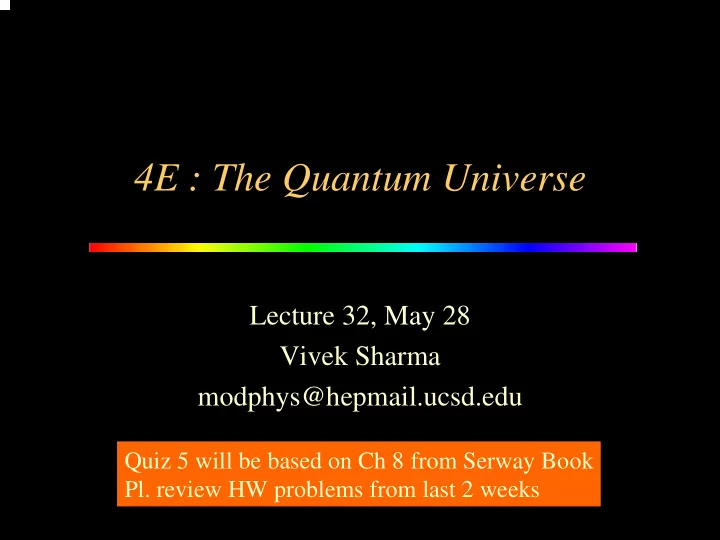

4E : The Quantum Universe Lecture 32, May 28 Vivek Sharma modphys@hepmail.ucsd.edu Quiz 5 will be based on Ch 8 from Serway Book Pl. review HW problems from last 2 weeks
2 Forces in Nature
3 Compton Scattering, Pair Production and Annihilation
Strong Interaction Between Protons and Neutrons Uncertainty Principle and range of strong force 4
5 Weak Force of Beta Decay : Uncertainty Principle
6 ? Unification of Physical Laws
7 Analogy: Are steam, water and ice manifestation of the same thing ? Unification of Forces
8 Pions (16) Cosmic Ray Smashing Through Nucleus Hadrons ! Fluorine Nuclear debris High energy Sulphur
9 Particle Categories: Hadrons & Leptons
10 2 ) 2 mc ( Particle Accelerators + 2 h , E = (pc) p λ =
Relativistic Force & Acceleration � � ⎛ ⎞ � dp d mu = = ⎜ ⎟ F � ⎜ ⎟ − dt dt 2 ⎝ ⎠ 1 ( / ) u c � � mu = = γ p mu − 2 1 ( / ) u c ⎡ ⎤ m du ⎢ ⎥ = ⎢ F : Relativistic Force ( ) ⎥ Relativistic 3/ 2 − dt 2 1 ( / ) u c ⎣ ⎦ � Force � du Since Acceleration a = , [rate of change of velocity] And dt Acceleration � � F 3/ 2 ⎡ ⎤ ⇒ − 2 a = 1 ( / ) u c ⎣ ⎦ m � Reason why you cant → → Note: As / u c 1, a 0 !!!! quite get up to the speed Its hard e r to accelerate when you get of light no matter how closer to speed of light hard you try! 11
Linear Particle Accelerator : Parallel Plates With Potential Difference F=-eE Parallel Plates - + e - E= V/d F= -eE E d V Charged particle q moves in straight line Under force, work is done � � on the particle, it gains in a uniform electric field E with speed u � � Kinetic energy accelarates under f orce F=qE � � � New Unit of Energy 3/ 2 3/ 2 ⎛ ⎞ ⎛ ⎞ � 2 2 du F u qE u = = − − ⎜ ⎟ ⎜ ⎟ a 1 = 1 2 2 1 eV = 1.6x10 -19 Joules ⎝ ⎠ ⎝ ⎠ dt m c m c 1 MeV = 1.6x10 -13 Joules larger the potential difference V a cross 1 GeV = 1.6x10-10 Joules plates, larger the force on particle 12
Linear Accelerator : 50 Billion Volts Accelerating Potential � � eE 3/ 2 ⎡ ⎤ − 2 a = 1 ( / ) u c ⎣ ⎦ m 13 PEP- -II accelerator schematic and tunnel view II accelerator schematic and tunnel view PEP
14 Discovery of Quarks: Constituents of Proton
High Energy Proton smashing into a Proton Rich Target Electron knocked 7 charged pions Out of an atom (road kill !) Λ 0 → p π - Incident proton 7 pions, 1 Kaon, 1 proton 15
Magnetic Confinement & Circular Particle Accelerator � � V Classically B 2 v = F m r � 2 v = qvB m r F B r γ dp d ( mu ) du = = = γ = F m quB dt dt dt 2 du u = (Centripetal accelaration) dt r 2 u γ = ⇒ γ = ⇒ = m quB mu qBr p qB r r 16
Charged Form of Matter & Anti-Matter in a B Field Antimatter form of electron = Positron (e + ) Same Mass but opposite Charge Positron curls the other way from electron in a B Field 17
18 Accelerating Electrons Thru RF Cavities
A Circular Accelerator : Using B Field to Confine the electron and RF cavity to power it 19
Circular Particle Accelerator: LEP @ CERN, Geneve Accelerated electron through an effective voltage of 100 Billion Volts ! To be upgraded to 7 trillion Volts by 2007 circular track for accelerating electron French Border Swiss Border Geneva Airport 20
21 Inside A Circular Particle Accelerator Tunnel : Monorail !
In Tunnel 150m underground, 27km ring of Magnets Keep electron in Circular Orbit 22
23 French Grad Student fixing magnet
24
25 Sequence of Events Following e + e - Annihilation universe! Baby
26 Collider Detector: Concentric Array of Specialized Particle Detectors
27 ALEPH: My Old “Camera” at CERN Discovered universe Of quarks & leptons Made of 3 families
28
29 DNA of Fundamental Particles: Vital Statistics
Some Quantum Numbers of Quarks Composite Particles are made of Quarks held by “glue” Proton = (uud); Neutron = (udd), Pion+ = (u dbar), K+ = (sbar d) 30
Some Open Questions In Particle Physics • How do particles get the masses they have? – Physicists believe particle masses are generated by interaction with a mysterious field that permeates the entire universe • Stronger the particle interacts with the field, the more massive it is – It could be a new fundamental field called HIGGS field – Or it may be a composite object made of new particles (techniquarks) tightly bound together by a new force (technicolor!) • Whatever the nature of this mass mechanism, odds are solid that it will be produced when beams of protons with energy of 7 TRILLION eV collide at the LHC accelerator – Could be seen as one or many new Higgs particle • If the Universe is made of >4 dimensions, some of the extra dimensions could “pop” out in these violent collisions • Little blackholes could also be produced in these high energy interactions….and the detector will catch them in action !! 31
32 Hunting for Higgs Particle With CMS Detector
33 Setting the Trap for Higgs Particle
Accelerators Permit Investigations of Fabric of Spacetime Is String theory the ultimate answer? Dr. Brian Wecht will tell you about String theory next week 34
Recommend
More recommend